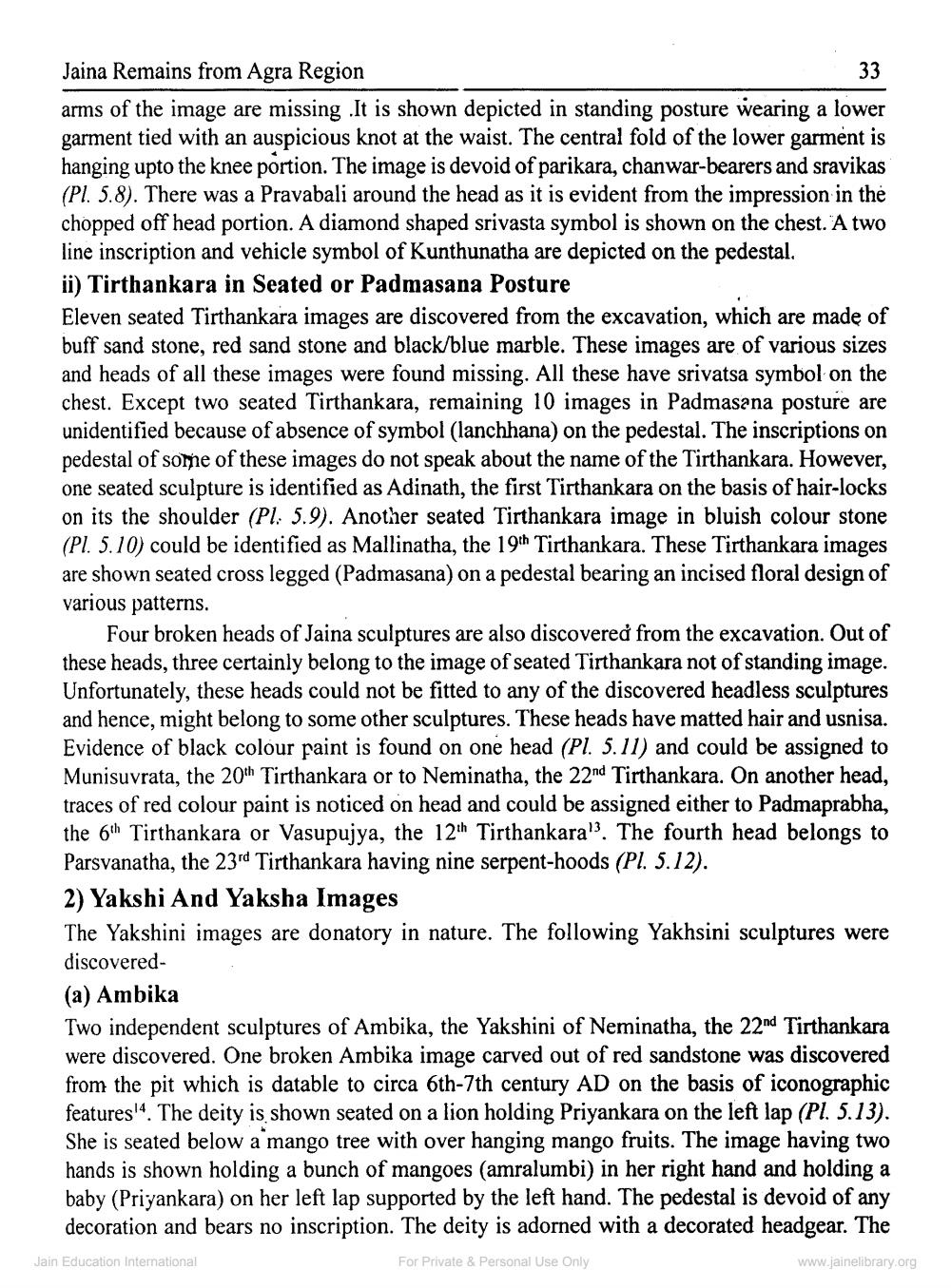________________
Jaina Remains from Agra Region
33 arms of the image are missing. It is shown depicted in standing posture wearing a lower garment tied with an auspicious knot at the waist. The central fold of the lower garment is hanging upto the knee portion. The image is devoid of parikara, chanwar-bearers and sravikas (Pl. 5.8). There was a Pravabali around the head as it is evident from the impression in the chopped off head portion. A diamond shaped srivasta symbol is shown on the chest. A two line inscription and vehicle symbol of Kunthunatha are depicted on the pedestal. ii) Tirthankara in Seated or Padmasana Posture Eleven seated Tirthankara images are discovered from the excavation, which are made of buff sand stone, red sand stone and black/blue marble. These images are of various sizes and heads of all these images were found missing. All these have srivatsa symbol on the chest. Except two seated Tirthankara, remaining 10 images in Padmasana posture are unidentified because of absence of symbol (lanchhana) on the pedestal. The inscriptions on pedestal of some of these images do not speak about the name of the Tirthankara. However, one seated sculpture is identified as Adinath, the first Tirthankara on the basis of hair-locks on its the shoulder (Pl: 5.9). Another seated Tirthankara image in bluish colour stone (Pl. 5.10) could be identified as Mallinatha, the 19th Tirthankara. These Tirthankara images are shown seated cross legged (Padmasana) on a pedestal bearing an incised floral design of various patterns.
Four broken heads of Jaina sculptures are also discovered from the excavation. Out of these heads, three certainly belong to the image of seated Tirthankara not of standing image Unfortunately, these heads could not be fitted to any of the discovered headless sculptures and hence, might belong to some other sculptures. These heads have matted hair and usnisa. Evidence of black colour paint is found on one head (Pl. 5.11) and could be assigned to Munisuvrata, the 20th Tirthankara or to Neminatha, the 22nd Tirthankara. On another head, traces of red colour paint is noticed on head and could be assigned either to Padmaprabha, the 6th Tirthankara or Vasupujya, the 12th Tirthankara'3. The fourth head belongs to Parsvanatha, the 23rd Tirthankara having nine serpent-hoods (Pl. 5.12). 2) Yakshi And Yaksha Images The Yakshini images are donatory in nature. The following Yakhsini sculptures were discovered(a) Ambika Two independent sculptures of Ambika, the Yakshini of Neminatha, the 22nd Tirthankara were discovered. One broken Ambika image carved out of red sandstone was discovered from the pit which is datable to circa 6th-7th century AD on the basis of iconographic features!4. The deity is shown seated on a lion holding Priyankara on the left lap (Pl. 5.13). She is seated below a mango tree with over hanging mango fruits. The image having two hands is shown holding a bunch of mangoes (amralumbi) in her right hand and holding a baby (Priyankara) on her left lap supported by the left hand. The pedestal is devoid of any decoration and bears no inscription. The deity is adorned with a decorated headgear. The
Jain Education International
For Private & Personal Use Only
www.jainelibrary.org




